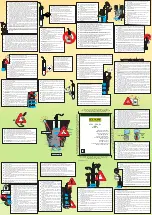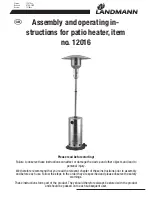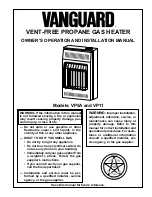
4
Installation & Service Manual
1
Determine water heater location
Installation
The equipment shall be installed in accordance with those
installation regulations in force in the local area where the
installation is to be made. These regulations shall be carefully
followed in all cases. Authorities having jurisdiction shall be
consulted before installations are made. In the absence of
such requirements, the installation shall conform to the latest
edition of the National Fuel Gas Code, ANSI Z223.1 and/or
CAN/CGA-B149 Installation Code. Where required by the
authority having jurisdiction, the installation must conform
to American Society of Mechanical Engineers Safety Code for
Controls and Safety Devices for Automatically Fired Boilers,
ASME CSD-1. All appliances conform to the latest edition of
the ASME Boiler and Pressure Vessel Code, Section IV. Where
required by the authority having jurisdiction in Canada, the
installation must comply with the CSA International CAN/
CGA-B149 and Installation Code and/or local codes.
This appliance meets the safe lighting performance criteria
with the gas manifold and control assembly provided, as
specified in the ANSI standards for gas-fired appliances, and
ANSI Z21.10.3
Figure 1-1 Typical (Front View) Cabinet Construction
Figure 1-2 Typical (Rear View) Cabinet Construction
Locating the water heater
1. Locate the appliance so that if water connections should
leak, water damage will not occur. When such locations
cannot be avoided, it is recommended that a suitable
drain pan, adequately drained, be installed under the
appliance. The pan must not restrict combustion air
flow. Under no circumstances is the manufacturer to be
held responsible for water damage in connection with this
appliance, or any of its components.
2. The appliance must be installed so that the ignition
system components are protected from water (dripping,
spraying, rain, etc.) during appliance operation and
service (circulator replacement, control replacement, etc.).
3. Appliances located in a residential garage and in adjacent
spaces that open to the garage and are not part of the
living space of a dwelling appliance must be installed
so that all burners and burner ignition devices have a
minimum clearance of not less than 18” (46 cm) above
the floor. The appliance must be located or protected
so that it is not subject to physical damage by a moving
vehicle.
4. DO NOT install this appliance in any location where
gasoline or flammable vapors are likely to be present.
5. The appliance must be installed on a level floor. A
combustible wood floor may be used without additional
bases or special floor buildup. Maintain required
clearances from combustible surfaces.
Summary of Contents for Efficiency-Pac EW 150 -- 300
Page 47: ...47 Notes ...





































